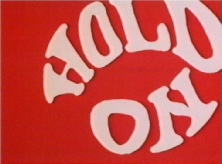The Dave Clark Five were effectively the second British Invasion band to make it
big in America, and much was made of their topping The Beatles in the UK singles
chart, so it was no surprise that Hollywood would call. In August 1964 they were
to star in, and write the entire score, for a Sam Katzman picture for MGM. Possible
co-stars included TV's Dr Kildare Richard Chamberlain and Hollywood veteran Mitzi
Gaynor. Katzman and a Hollywood unit would film at MGM's Boreham Wood studio in September
1964 with a possible release in November 1964 to co-inside with a six week American
tour. Although that project never happened Get Yourself A College Girl was made instead,
with the group only in a supporting role to star Nancy Sinatra.
By 1965 there seemed to be a desire for their own movie, their own A Hard Day's Night,
so John Boorman was roped in to direct Catch Us If You Can, easily one the best,
and strangest, British pop movies of the sixties. Author Peter Nicholls had typed
on the fly-leaf of his final script ‘To Valium, without which this film could not
have been written’. John Boorman, in his feature debut, used several character actors
from his British television work like Citizen 63 and The Newcomers in supporting
roles, giving the movie an almost documentary feel. After a while Boorman basically
abandons the other four members of the group to concentrate of Clark and the girlfriend,
played by Barbara Ferris.
The next step came in November 1966. Dave Clark and Mike Smith flew to Hollywood
to discuss the next DC5 movie, They’ll Never Get Away With It. The plot revolved
around a robbery in London, and although the band would play roles in the movie rather
than themselves, they would not be seen playing any songs, but would provide songs
and music in the background. Clark wanted either Brian Forbes or Tony Miles to direct
it, but neither had the time. Clark was later said to be in discussion with a French
director.
In September 1967 it was announced that Clark's Big 5 production company was to make
a non-music thriller later in 1967, while in January 1968 it was also announced that
it would make six TV specials, with Hold On It's The Dave Clark Five being the first.
It was an independently made show, broadcast across the ITV network, and according
to Clark it cost £45,000 to make. However, some clips used for Hold On had previously
appeared in a Dave Clark Five cinema support feature Hits In Action back in 1966.
Hold On featured the band in a recording studio, in comedy sketches, driving around
etc, while a couple of guest stars, Richard Chamberlain and Lulu were also thrown
in for support. Produced and directed by Clark, it was broadcast between 9.30 - 10.15
pm on a Saturday evening, possibly shown instead of a proposed Cliff Richard special
made by London Weekend, who were experiencing difficulties in their first few weeks
of broadcasting.
Talking to the TV Times' Dave Lanning about the show Clark claimed "You see, we asked
our guests what they would like to do, if they had any unfulfilled ambitions. This
way, you get them working on something they are interested in." For the record, Richard
Chamberlain chose to play a photographer; Lulu wanted to be a romantic actress--hence
that first stage kiss. "It has three distinct sections: the first part has Richard
Chamberlain in a parody scene from a recent photographer film, "Blow Up"; part two
features the group in comedy and action sequences to a background of non-stop music;
the final section has Lulu in her romantic scene, and a series of fast-cut film clips
featuring the group. "We've worked hard on the programme and now I can say I'm happy
about it. There are bound to be comparisons between this show and The Beatles. That's
okay by me." The Melody Maker claimed in August 1968 "Dave hopes it will be the first
of a Hold On series."
The desire to make another movie wouldn't go away as in February 1969 they were set
to star, write the script and the music, for the British movie The Instructor.
Hold On was repeated by several ITV channels in April 1969, but it was virtually
forgotten about until a showing on Channel 4 TV in the UK in May 1993 as a part of
their deal with Dave Clark International, which at the time included what was left
of Ready Steady Go.

